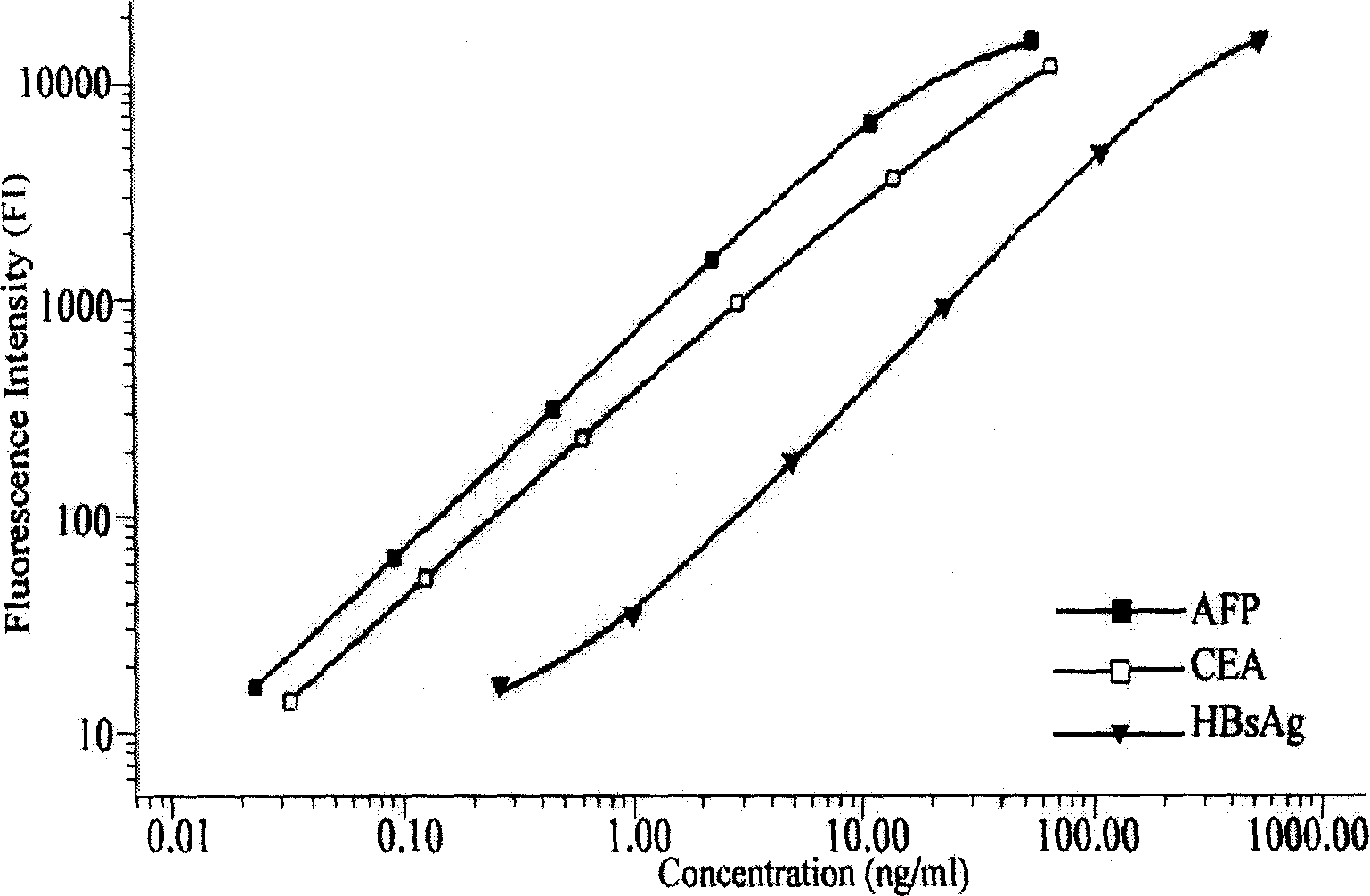Preparation method of liquid phase protein chip
A protein chip and liquid phase technology, applied in the field of liquid phase protein chip preparation, can solve the problems of low sensitivity, complicated labeling steps, cumbersome operation, etc., to improve sensitivity and detection range, save specimen and reagent consumption, and improve detection efficiency Effect
- Summary
- Abstract
- Description
- Claims
- Application Information
AI Technical Summary
Problems solved by technology
Method used
Image
Examples
Embodiment 1
[0039] Example 1: Preparation of liquid-phase protein chip
[0040] 1. Preparation of antibody-conjugated microspheres
[0041] (1) Take 2.5×10 6 Carboxylated microspheres (purchased from Luminex) were placed in a 1.5ml microcentrifuge tube, centrifuged at 13,000 rpm for 4 minutes, and the supernatant was discarded.
[0042] (2) Add 100 μl of deionized water, vortex and sonicate for 20 seconds to resuspend the microspheres. Centrifuge at 13,000 rpm for 4 minutes and discard the supernatant.
[0043] (3) Add 100 μl activation buffer (0.1mol / L NaH 2 PO 4 , pH 6.2), vortexed and sonicated for 20 seconds to resuspend the microspheres. Centrifuge at 13,000 rpm for 4 minutes and discard the supernatant.
[0044] (4) Add 80 μl of activation buffer, vortex and sonicate for 20 seconds to resuspend the microspheres.
[0045] (5) Weigh an appropriate amount of N-hydroxysulfosuccinimide (Sulfo-NHS) and carbodiimide (EDC) respectively, and prepare them with deionized water to a conc...
Embodiment 2
[0074] Embodiment 2: the preparation of the solution required for reaction
[0075] 1. Preparation of Standard Diluent
[0076] Prepare the standard dilution solution according to the following formula: 0.8% NaCl, 0.02% KCl, 0.29% Na 2 HPO 4 , 0.024% KH 2 PO 4 , 1.5-7.5% BSA, 0.01% Tween20, 0.05% sodium azide, pH7.4.
[0077] 2. Preparation of standard products
[0078] Take an appropriate amount of stock solutions containing high concentrations of CEA, AFP, and HBsAg antigens, and prepare standard substances 1-6 (Std1-Std6) and standard substance 7 ( Std7) is a standard product dilution without any antigen.
[0079] CEA (ng / ml)
AFP(U / ml)
HBsAg(ng / ml)
Std 1
80
55
1000
Std 2
16
11
200
Std 3
3.2
2.2
40
Std 4
0.64
0.44
8
Std 5
0.128
0.088
1.6
Std 6
0.032
0.022
0.4
Std 7
0
0
0
[0080] 3. Preparation of assay buffer ...
Embodiment 3
[0084] Example 3: The method of using the liquid-phase protein chip
[0085] 1. Vortex and sonicate the antibody-coupled microspheres of CEA, AFP, and HBsAg for 20 seconds to resuspend.
[0086] 2. Take an appropriate amount of microsphere suspension, and use the assay buffer to prepare a diluted microsphere mixture containing 80-100 microspheres with different fluorescent codes per μl.
[0087]3. Add 100 μl / well of assay buffer to the required reaction wells of a 96-well membrane filter plate (MultiScreen MABVN 1.2 μm) to pre-wet, seal the remaining wells with plate sealing film, and vacuum filter to remove the liquid.
[0088] 4. Add 25 μl / well of standard and serum samples (pre-diluted 25 times with standard diluent) to the standard wells (double wells can be set) and sample wells of the filter plate.
[0089] 5. Add 25 μl / well of the diluted microsphere mixture to the above wells.
[0090] 6. Seal the reaction well with a sealing film, and incubate at room temperature fo...
PUM
| Property | Measurement | Unit |
|---|---|---|
| Diameter | aaaaa | aaaaa |
Abstract
Description
Claims
Application Information
 Login to View More
Login to View More - R&D
- Intellectual Property
- Life Sciences
- Materials
- Tech Scout
- Unparalleled Data Quality
- Higher Quality Content
- 60% Fewer Hallucinations
Browse by: Latest US Patents, China's latest patents, Technical Efficacy Thesaurus, Application Domain, Technology Topic, Popular Technical Reports.
© 2025 PatSnap. All rights reserved.Legal|Privacy policy|Modern Slavery Act Transparency Statement|Sitemap|About US| Contact US: help@patsnap.com

